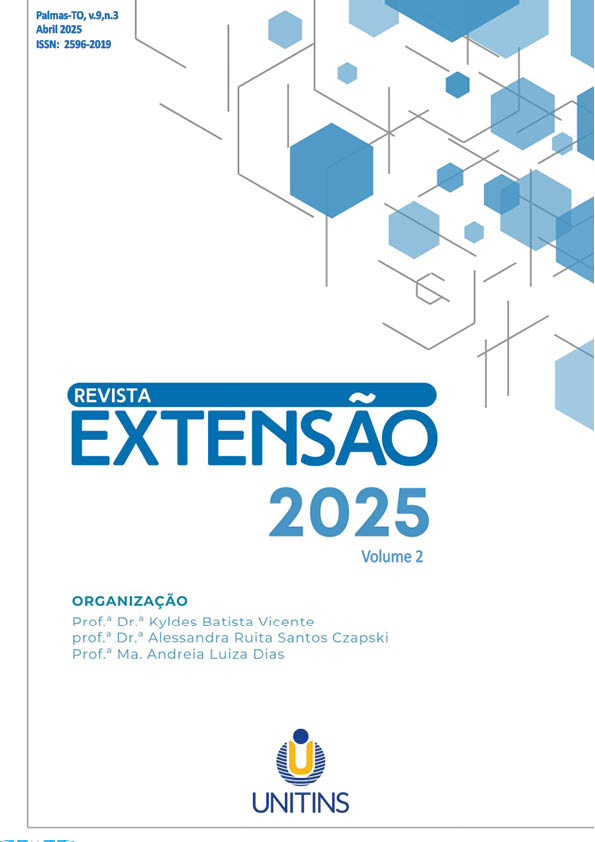PROJETO DE FISIOTERAPIA NA SAÚDE DA MULHER (PROFISM): ASSISTÊNCIA FISIOTERAPÊUTICA A MULHERES COM INCONTINÊNCIA URINÁRIA
Abstract
O Projeto de Fisioterapia na Saúde da Mulher (PROFISM) é um projeto de extensão do Departamento de Fisioterapia da Universidade Federal do Ceará (UFC). Este tem como propósito atuar em todas as etapas de avaliação e tratamento de mulheres com disfunções do assoalho pélvico atendidas na Maternidade Escola Assis Chateubriand (MEAC), além da promoção da saúde e prevenção dessas disfunções. Esse artigo tem como objetivo descrever o projeto, o fluxo de encaminhamentos, atendimentos e atividades assistenciais prestadas a mulheres com incontinência urinária. Trata-se de um estudo descritivo, do tipo relato de experiência. Os resultados foram divididos de forma a detalhar todas as etapas de tratamento pelas quais as pacientes passam ao serem atendidas pelo projeto. O PROFISM ao longo de uma década insere-se como um projeto transformador importante ao possibilitar a troca de saberes e a assistência à saúde a mulheres com disfunções do assoalho pélvico.
Downloads
References
ABRAMS, P. et al. Fourth International Consultation on Incontinence Recommendations of the International Scientific Committee: Evaluation and treatment of urinary incontinence, pelvic organ prolapse, and fecal incontinence. Neurourol Urodyn, v. 29, n. 1, p. 213-40, 2010. 4.
AOKI, Y. et al. Urinary incontinence in women. Nature Reviews Disease Primers, [S.L.], v. 3, n. 1, p. 1-20, 6 jul. 2017. Springer Science and Business Media LLC. http://dx.doi.org/10.1038/nrdp.2017.42.
AROUCA, M.A.F. et al. Validation and cultural translation for Brazilian Portuguese version of the Pelvic Floor Impact Questionnaire (PFIQ-7) and Pelvic Floor Distress Inventory (PFDI-20). International Urogynecology Journal, [S.L.], v. 27, n. 7, p. 1097-1106, 19 jan. 2016. Springer Science and Business Media LLC. http://dx.doi.org/10.1007/s00192-015-2938-8.
BARACHO, E. Fisioterapia aplicada à saúde da mulher. 6 ed. Rio de Janeiro: Guanabara Koogan, 2018.
BO, K. et al. An International Urogynecological Association (IUGA)/International Continence Society (ICS) joint report on the terminology for the conservative and nonpharmacological management of female pelvic floor dysfunction. Neurourology And Urodynamics, [S.L.], v. 36, n. 2, p. 221-244, 5 dez. 2016. Wiley. http://dx.doi.org/10.1002/nau.23107.
BURKHARD, F.C. et al. EAU guidelines on urinary incontinence 2016. Disponible sur: https://uroweb.org/guideline/urinary-incontinence, v. 3, 2018. 14.
CULBERTSON, S.; DAVIS, A.M. Nonsurgical Management of Urinary Incontinence in Women. Jama, [S.L.], v. 317, n. 1, p. 79, 3 jan. 2017. American Medical Association (AMA). http://dx.doi.org/10.1001/jama.2016.18433.
DEDICAÇÃO, A.C. et al. Comparação da qualidade de vida nos diferentes tipos de incontinência urinária feminina. Brazilian Journal of Physical Therapy, v. 13, p. 116-122, 2009. Disponível em: https://www.scielo.br/j/rbfis/a/vPfmPRbJBq64ZN95QgB6jbB/?format=pdf&lang=en
DUMOULIN, Chantale et al. Pelvic floor muscle training versus no treatment, or inactive control treatments, for urinary incontinence in women. Cochrane Database Of Systematic Reviews, [S.L.], v. 2018, n. 10, p. 1-158, 4 out. 2018. Wiley. http://dx.doi.org/10.1002/14651858.cd005654.pub4.
FIGUEIREDO, V.B. et al. Effects of individual pelvic floor muscle training vs individual training progressing to group training vs group training alone in women with stress urinary incontinence: a randomized clinical trial. Neurourology and Urodynamics, v. 39, n. 5, p. 1447-1455, 2020. 9. Disponível em: onlinelibrary.wiley.com/doi/abs/10.1002/nau.24370
FUNADA, S. et al. Cognitive behavioral therapy for overactive bladder in women: study protocol for a randomized controlled trial. BMC urology, v. 20, p. 1-10, 2020.
HAYLEN, B.T et al. An International Urogynecological Association (IUGA)/International Continence Society (ICS) joint report on the terminology for female pelvic floor dysfunction. Neurourology and Urodynamics: Official Journal of the International Continence Society, v. 29, n. 1, p. 4-20, 2010. 3. Disponível em: https://onlinelibrary.wiley.com/doi/abs/10.1002/nau.20798
HERRMANN, V. et al. Eletroestimulação transvaginal do assoalho pélvico no tratamento da incontinência urinária de esforço: avaliações clínica e ultra-sonográfica. Revista da Associação Médica Brasileira, [S.L.], v. 49, n. 4, p. 401-405, 2003. Elsevier BV. http://dx.doi.org/10.1590/s0104-42302003000400031.
LAMB, S.E. et al. Group treatments for sensitive health care problems: a randomised controlled trial of group versus individual physiotherapy sessions for female urinary incontinence. BMC Women's Health, v. 9, p. 1-9, 2009.
LAYCOCK, J. et al. Pelvic Floor Muscle Assessment: the perfect scheme. Physiotherapy, [S.L.], v. 87, n. 12, p. 631-642, dez. 2001. Elsevier BV. Disponível em: https://doi.org/10.1016/S0031-9406(05)61108-X
LÓPEZ-LIRIA, R. et al. Effectiveness of physiotherapy treatment for urinary incontinence in women: a systematic review. Journal of Women's Health, v. 28, n. 4, p. 490-501, 2019. 6.
MEINBERG, M.F. Adaptação cultural e validação da escala de Wexner em mulheres com incontinência anal na população brasileira. 2014. Disponível em: https://repositorio.ufmg.br/handle/1843/BUBD-A2MG5Q
MÉNDEZ, Luísa María Gómez et al. Behavioral therapy in the treatment of urinary incontinence: quality of life and severity. Fisioterapia em Movimento, [S.L.], v. 35, n. , p. 1-9, 2022. FapUNIFESP (SciELO). http://dx.doi.org/10.1590/fm.2022.356014.
PINHEIRO, Brenda de Figueiredo et al. Fisioterapia para consciência perineal: uma comparação entre as cinesioterapias com toque digital e com auxílio do biofeedback. Fisioterapia em Movimento, [S.L.], v. 25, n. 3, p. 639-648, set. 2012. FapUNIFESP (SciELO). http://dx.doi.org/10.1590/s0103-51502012000300019.
PIZZOL, D. et al. Urinary incontinence and quality of life: a systematic review and meta-analysis. Aging clinical and experimental research, v. 33, p. 25-35, 2021.
RIETJENS, P. et al. Importância da propriocepção e consciência muscular no tratamento de disfunções pélvicas. Femina, S.I, v. 44, n. 4, p. 198-200, 2016.
TEIXEIRA, J.A. et al. A fisioterapia pélvica melhora a dor genitopélvica/desordens da penetração? Femina, Minas Gerais, v. 45, n. 3, p. 187-193, 2017. Disponível em: https://docs.bvsalud.org/biblioref/2020/02/1050721/femina-2017-453-187-192.pdf
PEREIRA, V.S. et al. Tradução e validação para a língua portuguesa de um questionário para avaliação da gravidade da incontinência urinária. Revista Brasileira de Ginecologia e Obstetrícia, v. 33, p. 182-187, 2011.
WOODLEY, S.J. et al. Pelvic floor muscle training for preventing and treating urinary and faecal incontinence in antenatal and postnatal women. Cochrane Database of Systematic Reviews, n. 5, 2020 Disponível em: https://www.cochranelibrary.com/cdsr/doi/10.1002/14651858.CD007471.pub4/full .



